India Indian music music vocalists: 78 rpm discs
by Warren
1 comment
Meta
SiteMeter
Brighter Planet
78 rpm Records of Indian Music: Bangri Geets by Sardar Bai
This disc was part of the collection of 78s I acquired in Udaipur in 2000. These songs would appear to be in the Bangri language, which is also known as Haryanvi.
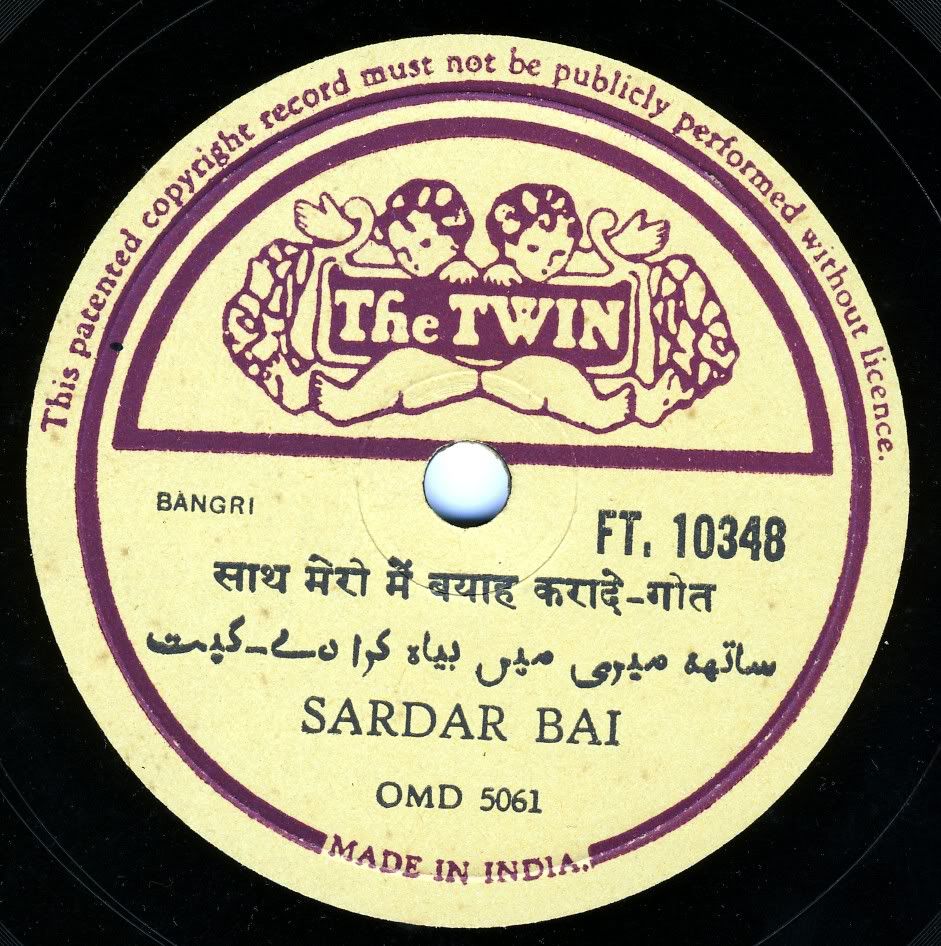
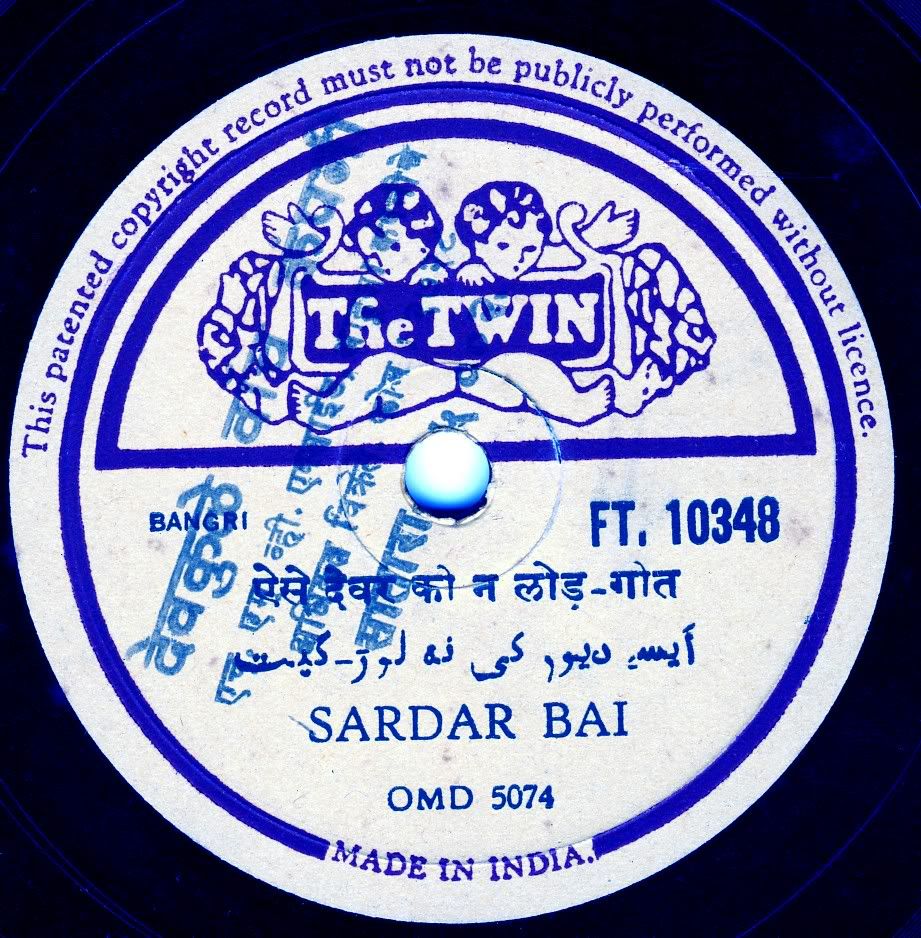
It is possible that this music is specific to the Bangri people, about whom little information is available beyond this:
The 5.7 million Bangri are located mainly in the states of Haryana, Karnataka, Himachal Pradesh, Uttar Pradesh, Punjab, and Delhi. Their language, Bangaru, is a member of the Indo-Aryan language family. Little is known about their specific lifestyle and culture.
Link
Irritatingly for my atheistic self, the site is that of PrayWay, a “global prayer community” that lists the Bangri among the world’s “unreached” peoples:
* People name: Bangri
* Country: India
* Their language: Bangaru
* Population:
(1990) 5,251,200
(1995) 5,776,500
(2000) 6,309,100
* Largest religion:
Hindu 98.4%
* Christians: 1.6%
* Church members: 92,425
* Scriptures in their own language: None
* Jesus Film in their own language: None
* Christian broadcasts in their own language: None
* Mission agencies working among this people: 2
* Persons who have heard the Gospel: 1,421,000 (25%)
Those evangelized by local Christians: 439,000 (8%)
Those evangelized from the outside: 982,000 (17%)
* Persons who have never heard the Gospel: 4,355,500 (75%)
Fortunately for us, there’s no need to convert these folks; let’s just listen to these two songs.
No information is available about Sardar Bai; there have been various well-known singers with that name in India’s recent history. I’m betting this isn’t one of them.
Saath Meri Men Bayaah Karaade
Aise Devar Ko Na Lod
India Indian music music vocalists: 78 rpm discs weirdness
by Warren
1 comment
Meta
SiteMeter
Brighter Planet
78 rpm Records of Indian Music: Hindustani Comic Song by Mr. Muradaly & Others
I have no information on “Mr. Muradaly and others.” But as I was pawing through a big stack of 78s in the middle of Chor Bazaar years ago, my eye was caught by this record.
How could I resist a “Hindustani Comic Song”?
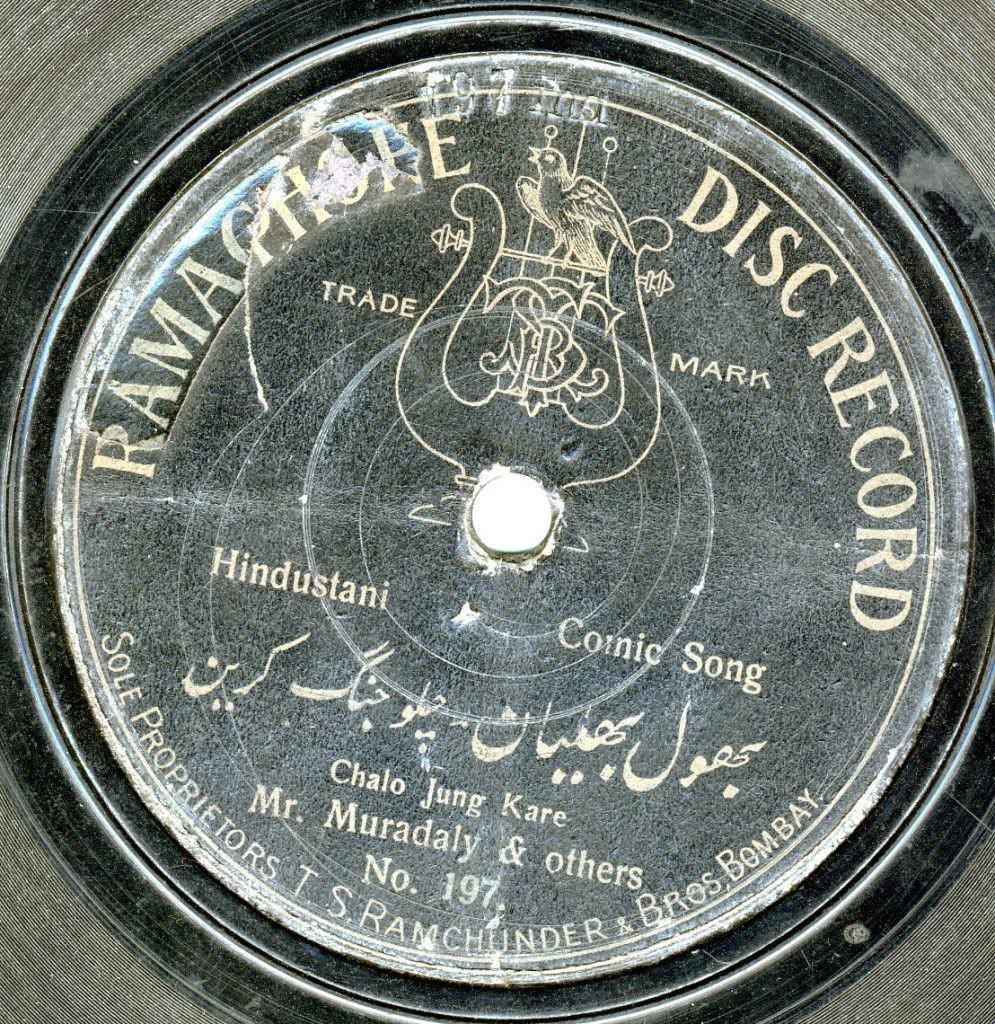
“Chalo Jung Kare” translates roughly as, “Come! Let’s go to war,” and indeed the military is clearly being lampooned, what with bugle calls and all. Do I detect some dialect humor?
Enjoy.
India Indian music music vocalists: 78 rpm discs genius
by Warren
8 comments
Meta
SiteMeter
Brighter Planet
78 rpm Records of Indian Music: Mr. Vishnupant Pagnis
Vishnupant Pagnis was one of the great voices of Marathi theater and early film. As these two recordings show, he was a hell of a singer.
Vishnupant Pagnis was an actor in Marathi theatre. At the age of 10 he joined Janubhau Nimkar`s Swadesh Hitachintak Natak Mandali in Kolhapur as an actor of female roles. His portrayals of Deval`s Sharada and Shakuntala in command performances for Shahu Maharaja won him popularity. He gained fame for creating the heroines of Warerkar`s first play Kunjavihari or `Wanderer in Gardens` in 1908 and Govindrao Tembe`s Shivraj Natak Mandali production in Hindi of Manishankar Trivedi`s Siddha-sansar or `Successful Life` in 1916.
The style of the celebrated Gujarati female impersonator, Jaishankar Sundari, is said to have influenced him. He appeared in Warerkar`s early silent film, Poona Raided in 1924. After his Sangitnatak career flagged, he taught music in a municipal school. A last-minute casting decision for the eponymous role in the successful movie Sant Tukaram or `Saint Tukaram` in 1936, he went on to play the lead in such“saint` films as Sant Tulsidas in 1939, Narsi Bhagat in 1940, and Mahatma Vidur in 1943, and grew famous as a Kirtan singer. He also headed a short-lived theatre company, Jagchhitradarshak Natak Mandali. Vishnupant Pagnis died in 1943.

He played the lead role in the film “biography” of the saint-poet Tukaram:
Sant Tukaram was also the subject of a biopic, title Sant Tukaram, made in 1936 by V. Damle and S. Fattelal of the Prabhat Film Company, starring Vishnupant Pagnis as the lead, and released on December 12, 1936 at the Central Cinema in Mumbai. The film was a big hit, and broke all previous records by running continuously for 57 weeks.[3] It also had won an award at the 5th Venice International Film Festival in 1937, and still remains a part of film appreciation courses.[4][5][6] It is preserved at the National Film Archive of India.[3]
Wiki
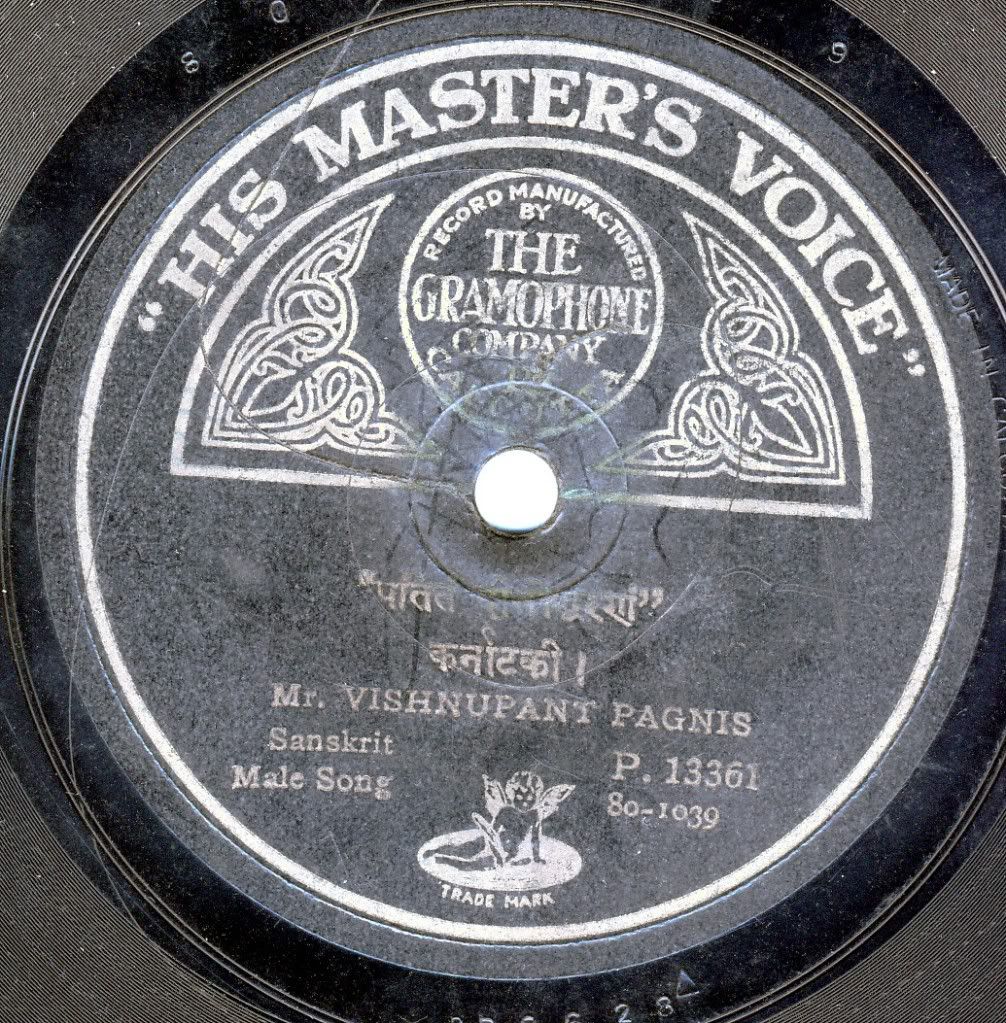
These two performances are from the early years of the twentieth century. The first is the celebrated patriotic song, Vande Mataram:
Vande Mataram (Devanagari: वन्दे मातरम्); Vande Mātaram “I bow to thee, Mother”) is a poem in the 1882 novel Anandamatha by Bankimchandra Chattopadhyay. It is written in a mixture of Bengali and Sanskrit.[1] It is a hymn to the goddess Durga, identified as the national personification of India. It came to be considered the “National Song of India”,[2] and it played a part in the Indian independence movement, first sung in a political context by Rabindranath Tagore at the 1896 session of the Indian National Congress.[3] In 1950, its first two verses were given the official status of “national song” of the Republic of India,[3] distinct from the national anthem of India Jana Gana Mana.
Wiki
Vande Mataram
And here is Patita Deenoduranan, a “Karnataki geet” in Sanskrit:
India Indian music music vocalists: 78 rpm discs
by Warren
2 comments
Meta
SiteMeter
Brighter Planet
78 rpm Records of Indian Music: Mr. Bhagoo of the New Alfred D. Company
Mr. Bhagoo, as the record label tells us, was one of the singers affiliated with the New Alfred D. Company, perhaps the most prominent theater group presenting Hindi and regional language drama at the beginning of the twentieth century.

His fine melismatic technique allows him to incorporate some tappa-ang taankari in this short performance.
Jake Chitme Chinta Buse
India Indian music music: 78 rpm discs genius
by Warren
1 comment
Meta
SiteMeter
Brighter Planet
78 rpm Records of Indian Music: Ali Ahmed Hussain – Shehnai
Ustad Ali Ahmed Hussain may not be as widely known as the great Shehnai master Bismillah Khan, but he’s an extraordinary player with a beautiful tone and a wonderfully lyrical approach:
Ustad Ali Ahmed Hussain Khan of Allahabad, the acknowledged premier shehnai specialist of Eastern India was born in Calcutta on March 21, 1939. His grand-father late Ustad Wazir Ali Khan was the first to demonstrate Indian classical music on shehnai at Buckingham Palace. His father late Ustad Ali Jan Khan and gurus late uncle Ustad Nazir Hussain Khan and late Ustad Imdad Hussain Khan of Benares were also renowned shehnai specialists. He presents shehnai in a soft, subtle and sweet tone enriched with melodious and mellifluous patterns. The purity of raags in his performances is a hallmark of his steadfastness to tradition. He has taught shehnai at Sangeet Research Academy, Calcutta since 1974.
He’s still playing, and he’s got his own website.
Enjoy these two short pieces of light classical music for their lilting melody and graceful improvisations
Kajri
Dadra
India Indian music music vocalists: 78 rpm discs
by Warren
1 comment
Meta
SiteMeter
Brighter Planet
78 rpm Records of Indian Music: The Twin Dramatic Party
This two-side-long piece is part of a drama in Urdu, based on the story of “Khosrow and Shirin”:
“Khosrow and Shirin” (Persian: خسرو و شیرین) is the title of several Persian epic poems. The essential narrative is a love story of Persian[1] origin, which is found in the great epico-historical poems of Shahnameh and which is based on historical figures that were elaborated and romanticized by later Persian poets. Variants of the story were also told under the titles “Khosrow and Farhad” and “Farhad and Shirin”.


Shirin Pharhaad
India music vocalists: 78 rpm discs
by Warren
1 comment
Meta
SiteMeter
Brighter Planet
78 rpm Records of Indian Music: Pandit Chand Narayan
No information is available about Pt. Chand Narayan. These two songs in Raga Bhairavi and Sindhu Bhairavi are beautiful performances with a pervasive ethos that rises up out of the swirling distortion and surface noise.

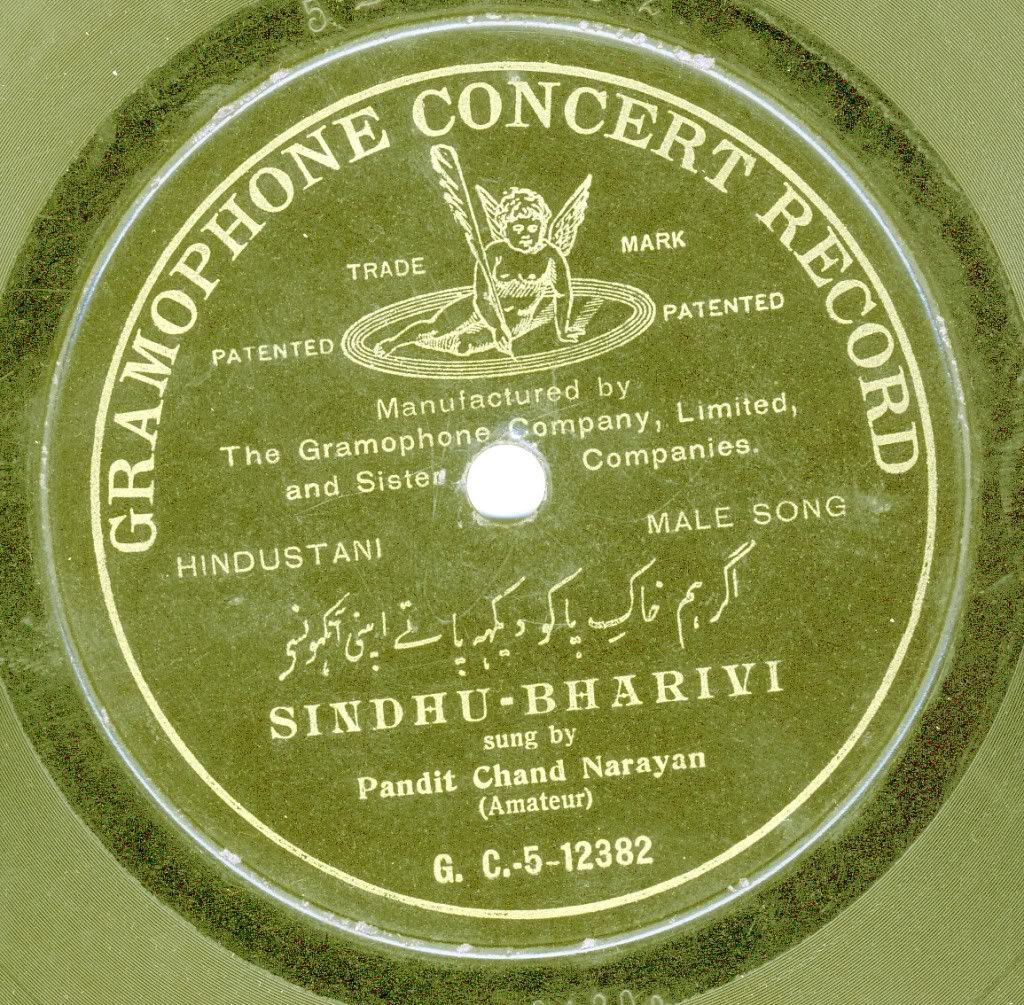
Ghazal in Raga Bhairavi
Raga Sindhu Bhairavi
India Indian music music: 78 rpm discs genius pakhawaj rhythm tabla
by Warren
1 comment
Meta
SiteMeter
Brighter Planet
78 rpm Records of Indian Music: Ustad Amir Hussain Khan and Pt. Madhavrao Alkutkar
Here is another great set of rhythmic music — a tabla/pakhawaj duet between Ustad Amir Hussain Khan and Pt. Madhavrao Alkutkar. These 78s were part of the group I acquired stateside from another collector who had no interest in Indian music.
The two artists play two different taals side by side. Jhaptaal and Jhampa have the same number of beats (10), while Rupak and Dhamar are 7 and 14 beats respectively. The performances are too short…but brilliant!
Enjoy.
Jhaptaal aur Jhampa
Rupak aur Dhamar
India Indian music music: 78 rpm discs genius pakhawaj rhythmic cycles
by Warren
leave a comment
Meta
SiteMeter
Brighter Planet
78 rpm Records of Indian Music: Pt. Govindrao Burhanpurkar – Pakhawaj
Here is a two-sided performance of Chautaal by the pakhawajiya Govindrao Burhanpurkar. Amazing stuff:
India Indian music music: 78 rpm discs Dance genius
by Warren
1 comment
Meta
SiteMeter
Brighter Planet
78 rpm Records of Indian Music: Kathak Dance by Sitara Devi
Here is a very unusual item: four 3-minute performances of Kathak dance by the great Sitara Devi:
Sitara Devi (born early 1920s on a Diwali day) is an eminent Indian dancer of the classical Kathak style of dancing. When she was in her teens, Rabindranath Tagore, after watching a performance by her described her as Nritya Samragini, meaning, the empress of dance. The epithet continues, and she is still described as the Kathak queen.
Wiki

This rare boxed set was part of a group of 78s that were sent to me by a fellow collector.
Sitara Devi is among the great dancers of modern India. Born in Calcutta, she was trained in Kathak by her father Shri Sukhdev Maharaj Misra and by masters of Lucknow gharana including Achhan Maharaj, Lachhu Maharaj and Shambu Maharaj. She has combined the traditions of Banaras and Lucknow in her performance of Kathak.
An exhaustive treatment of the entire gamut of nritta, sometimes in different talas, interspersed with gats of lyrical beauty and compositions of dramatic intensity followed by moving renditions of thumris and Bhajans constitute the format of her hours long performances, characterized by an electrifying energy. In many ways she represents a lost era of complete Kathak performed all night with the accompaniment of masters of Tabla like Kanthe Maharaj, Samta Prasad and Kishan Maharaj.
Sitara Devi has danced extensively in India and abroad contributing to the popularization of the art. She has also been an actess and dancer in films since the silent era. In a class of her own, she continues to inspire her audience and fellow artists.
She has been honoured with the Sangeet Natak Akademi Award (1969) and the Padma Shri.
Moordhan Poornam & Trotakam
Parahang
Padakriya (Tatkar)
Tarana
